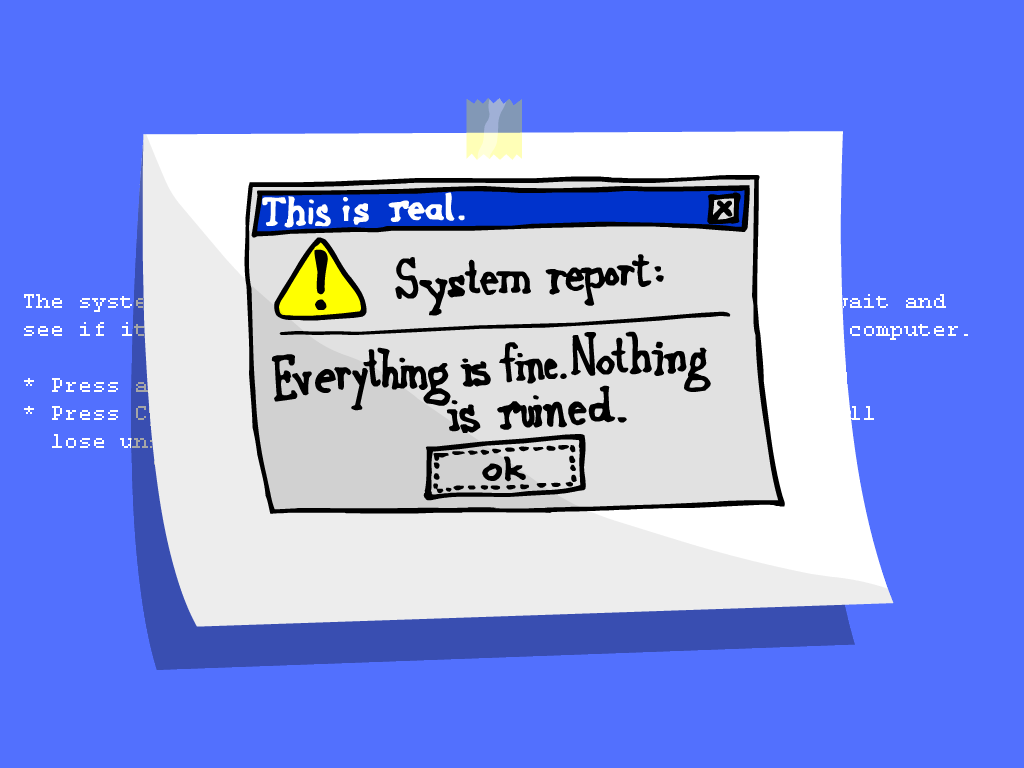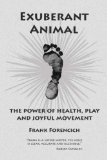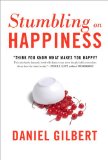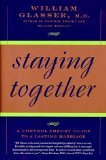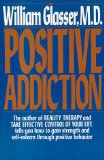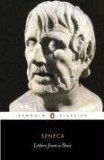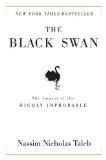Stumbling on Happiness by Daniel GilbertFinished reading
Stumbling on Happiness (SoH) by Daniel Gilbert last night, which weighs at about 240 pages and is an easy and informative discussion of the human mind, how we perceive the past and future, and our own ineptitude at understanding what makes us happy. It’s explicitly
not a self-help book or a guide to finding happiness. SoH is more an expose on how our minds work to deal with reality, remember the past, and predict the future.
In short, we’re not very good at doing any of the above and Gilbert does a pretty excellent job at explaining why.
While reading SoH, I marked various pages that I found particularly insightful. I’m sharing those bits and pieces below, as transcribed from the book.
Note: This “review” is a bit long because I’m recording some of the core concepts of SoH for future reference (If I don’t do this, I’ll probably forget them!).
On the importance of control with regard to human well-being (Chapter 1, Prospection and Control):
Knowledge is power, and the most important reason why our brains insist on simulating the futrue even when we’d rather be here now, enjoying a goldfish moment, is that our brains want to control the experiences we are about to have.
[Regarding why we want control,] There are two answers to this question, one of which is surprisingly right and the other of which is surprisingly wrong.
The surprisingly right answer is that people find it gratifying to exercise control—not just for the futures it buys them, but for the exercise itself. Being effective … is one of the fundamental needs with which human brains seem to be naturally endowed …
… Research suggests that if [we] lose [our] ability to control things at any point between [our] entrance [into the world] and exit, [we] become unhappy, helpless, hopeless, and depressed. …
Our desire to control is so powerful, and the feeling of being in control so rewarding, that people often act as though they can control the uncontrollable.
We want—and we should want—to control the direction of our [lives] because some futures are better than others … This idea is so obvious that it barely seems worth mentioning, but I’m going to mention it anyway. Indeed, I am going to spend the rest of this book mentioning it because it will probably take more than a few mentions to convince you that what looks like an obvious idea is, in fact, the surprisingly wrong answer to our question. We insist on steering our [lives] because we think we have a pretty good idea of where we should go, but the truth is that much of tour steering is in vain … because the future is fundamentally different than it appears through the prospectiscope.
In other words, the futures we expect to have given we do X or Y are never the same way as we expect them to be when we imagine them now.
On our brains doing the “filling-in” trick and imagining thing we could not know (Chapter 4, Onward). This reminds me of jumping to conclusions or the logical fallacy of the “hasty generalization,” though both fail to capture what our minds are doing, which is using a great deal of spackling to fill in holes.
Your mistake was not in imagining things you could not know—that is, after all, what imagination is for. Rather, your mistake was in unthinkingly treating what you imagined as though it were an accurate representation of the facts. …
Without the filling-in trick you would have sketchy memories, an empty imagination, and a small black hole following you wherever you went … We see things that aren’t really there and we remember things that didn’t really happen, and while these may sound like symptoms of mercury poisoning, they are actually critical ingredients in the recipe for a seamlessly smooth and blessedly normal reality. … Even though we are aware … of the filling-in trick, we can’t help but expect the future to unfold with the details we imagine.
And on how the brain leaves things out (Chapter 5, Absence in the Present), Gilbert cites Francis Bacon:
Nearly four centuries ago, the philosopher and scientist Sir Francis Bacon wrote about the ways in which the mind errs, and he considered the failure to consider absences among the most serious:
By far the greatest impediment and aberration of the human understanding arises from [the fact that] . . . those things which strike the sense outweigh things which, although they may be more important, do not strike it directly. Hence, contemplation usually ceases with seeing, so much so that little or no attention is paid to things invisible.
I’ll circle back to this later, but this is strikingly similar to our abilities to justify action over inaction, which Gilbert addresses later in the book.
Gilbert further illustrates how our brains leave out important details in discussing siamese twins and blind people who are unquestionably happy. Those of us without such disabilities have a hard time appreciating how individuals stricken with a dehabilitating problem could be just as, if not more happy than us. That is because our brains leave out important details. Regarding blind people, Gilbert writes (Chapter 5, Absence in the Future):
[W]hen sighted people imagine being blind, they seem to forget that blindness is not a full-time job. Blind people can’t see, but they do most of the things that sighted people do—they go on picnics, pay their taxes, listen to music, get stuck in traffic—and thus they are just as happy as ighted people are. They can’t do everything sighted people can do, sighted people can’t do everything that they can do, and thus blind and sighted lives are not identical. But whatever a blind person’s life is like, it is about much more than blindness. And yet, when sighted people imagine being blind, they fail to imagine all other things that such a life might be about, hence they mispredict how satisfying such a life can be.
Later in Chapter 5 Gilbert makes the astute analogy between how when we see off in the distance of space, our brains understand that we are unable to make out many details of the far-off objects, like the hairs on buffalo far off in the horizon; however, when we see off in the distance of time (either remembering the past or imagining the future), we fail to appreciate the many details our temporal perception may leave out (On the Event Horizon):
But when we remember or imagine a temporally distant event, our brains seem to overlook the fact that the details vanish with temporal distance, and they conclude instead that the distant events actually are as smooth and vague as we are imagining and remembering them.
One interesting part of the book describes how we use our brain hardware to imagine. This means that when we imagine a song or a picture in our heads, we trigger the parts of the brain that deal with visual or audio stimuli. This works reasonably well, but it is difficult for our brains to multi-task the hardware, which means that when we are feeling a certain way, that feeling impacts our imagining of something else – like the past or future. Gilbert writes (Chapter 6, Onward):
Each of us is trapped in a place, a time, and a circumstance, and our attempts to use our minds to transcend those boundaries are, more often than not, ineffective. … We think we are thinking outside the box only because we can’t see how big the box really is. Imagination cannot easily transencd the boundaries of the present, and one reason for this is that it must borrow machinery that is owned by perception. The fact that these two processes must run on the same platform means that we are sometimes confused about which one is running. We assume that what we feel as we imagine the future is what we’ll feel when we get there, but in fact, what we feel as we imagine the future is often a response to what’s happening in the present. The time-share arrangement between perception and imagination is one of the causes of presentism …
Gilbert goes on to discuss the balance our minds strike between the real and the illusory, and that this balance is achieved by the competing forces of what motivates us (the illusory) and what keeps us grounded (the real). He writes in Chapter 8, Cooking with Facts:
We cannot do without reality and we cannot do without illusion. each serves a purpose, each imposes a limit on the influence of the other, and our experience of the world is the artful compromise that these tough competitors negotiate.
Rather than thinking people as hopelessly Panglossian, then, we might think of them as having a psychological immune system that defends the mind against unhappiness in much the same way that the physical immune system defends the body against illness.
The idea of our minds as having an immune system over otherwise cold-hard depressing truths is particularly apt. How often are we able to find the silver-lining on the darkest, most depressing of clouds? Indeed, this is almost certainly an evolved trait that forces us to press onward despite real, painful realities.
Two of the best ideas that Gilbert illustrates in SoH demonstrate the implications of having a psychological immune system. For one, the present of this mental immune system incites us to prefer action over inaction (Chapter 9, Looking Forward to Looking Backward):
But studies also show that nine out of ten people are wrong. Indeed, in the long run, people of every age and in every walk of life seem to regret not having done things much more than they regret things they did …
But why do people regret inactions more than actions? One reason is that the psychological immune system has a more difficult time manufacturing positive and credible views of inactions than of actions. … The irony is all too clear: Because we do not realize that our psychological immune systems can rationalize an excess of courage more easily than an excess of cowardice,we hedge our bets when we should blunder forward.
The second point is that despite how we seem to believe we want as much choice and freedom as possible, our psychological immune system is so effective at its job that we are often better off without choice because the restrictions imposed by unchangeable decisions elicit compensatory justification by our minds, which enables us to make peace and appreciate our somewhat restricted positions (The Inescapability Trigger):
The costs and benefits of freedom are clear—but alas, they are not equally clear: We have no trouble anticipating the advantages that freedom may provide, but we seem blind to the joys it can undermine.
Somewhat related to Bacon’s observation that we tend to ignore the absences is the reality that unusual experiences stand out in our minds, tricking us into thinking they are the norm, when we are forgetting that the norm is the usual. Said better by Gilbert in Chapter 10, The Least Likely of Times:
The fact that the least likely experience is often the most likely memory can wreak havoc with our ability to predict future experiences.
In SoH Gilbert explains the idea of super-replicators, an idea explaining why certain genes are transmitted successfully, and applies this idea to belief systems. The super-replicator idea is simply that “any ( gene | idea ) that promotes its own “means of transmission” will be represented in increasing proportions in the population over time.” The idea of the super-replicator immediately elicits thoughts of the spreading of religion (and hark remembrances of Neal Stephenson’s Snow Crash):
If a particular belief has some property that facilitates its own transmission, then that belief tends to be held by an increasing number of minds. … [T]here are several such properties that increase a beleif’s transmissional success, the most obvious of which is accuracy.
I’d substitute usefulness or efficacy for accuracy, but the point is well made. There are ideas, both good and bad, that propagate and self-replicate. Gilbert goes into details on some of these ideas, perhaps the most prominent being the belief that money == happiness. The entire notion of self-replicating ideas is a great meta idea that, though related to how we perceive the world, could probably be expanded and written on in its own book.
At the end of SoH, Daniel Gilbert suggests a solution to help deal with our innately handicapped ability to perceive the future (and know what will make us happy). It’s pretty simple: observe others who are experiencing what you either will experience or want to experience. Watch how they feel because more often than not, the way they feel given a set of circumstances is likely to be how you would feel under the same. Gilbert calls this using surrogates, and it makes a lot of sense in theory though I can imagine it being incredibly difficult to put into practice. This is because we overestimate our own uniqueness in relation to other human beings when. As noted earlier, we are blind to how a blind man could be as happy as we are because we only see their blindness as a unique difference rather than seeing the gross majority of similarities.
All in all, some great insights are elicited in Gilbert’s Stumbling on Happiness. I have to recommend it!

